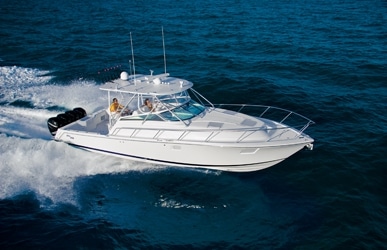
SeaVee 430 Sport Express
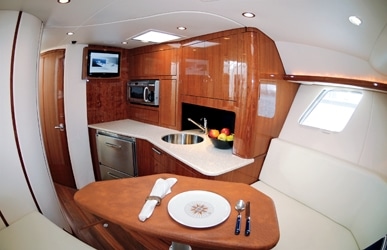
SeaVee 430 Sport Express
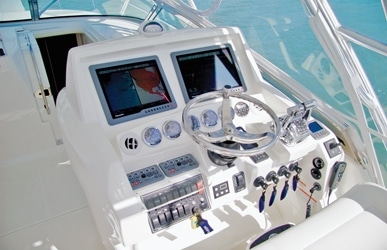
SeaVee 430 Sport Express
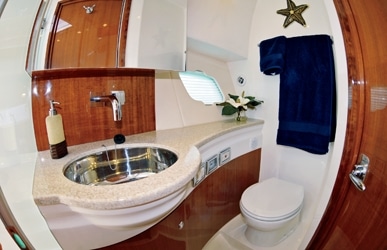
SeaVee 430 Sport Express
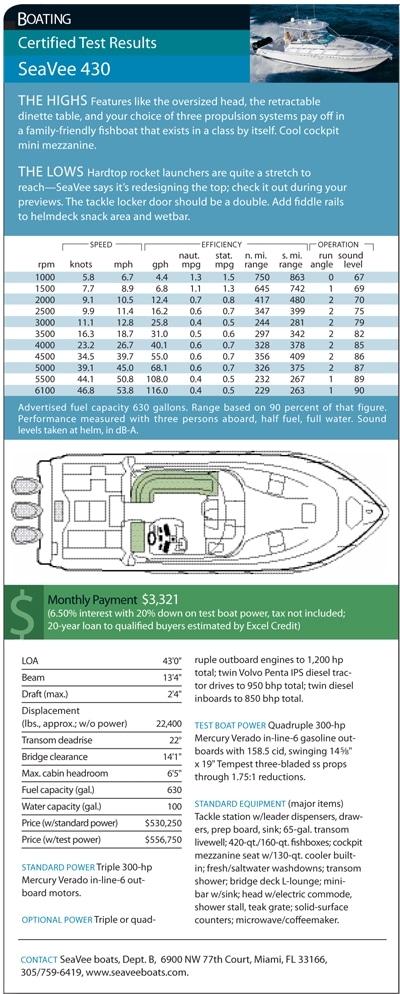
SeaVee 430 Sport Express Specs
What do blue tape and foam board have to do with building a hit new family-friendly fishboat? According to Robert Kaidy of Ocean5, the firm that designed the SeaVee 430 SE, almost everything. Kaidy used three rolls of tape to outline a full-sized accommodation plan on the floor of SeaVee headquarters. SeaVee kept the tape in place for months, living with the plan and tweaking it. Then a full-sized, foam-board mockup was built, which was followed by more tweaks and decisions regarding build processes, installations, and accessories. Finally a design was committed to tooling. The result is the fastest, most fishable cruiser I’ve ever tested. Ever.
This doesn’t mean it’s perfect. I’d change the tackle locker’s large single door. Smaller double doors are easier to manage in rough seas or at high speeds, scenarios in which the 430 SE will thrive. No surprise there, as SeaVee’s impeccable track record of building rugged, good-running boats proves. What’s surprising is how this renowned builder of center consoles turned out a cabin boat that rivals the best cruisers on the water.
Middle Management
The 430 SE was built so it runs right no matter which of its three power choices you opt for. In addition to the quadruple outboards powering my test boat, you can elect Volvo Penta’s IPS or choose conventional shaft inboards. Each choice changes the boat’s center of gravity (CG). To handle this, a sizable boat is required, such as the 430 SE. It must have enough hull bottom to handle the weight shift between, say, outboards on a bracket and inboards mounted in the bilge. If you order IPS, the engines sit directly in the CG. Placing weight on the CG has no effect on fore-and-aft trim. Order inboards or IPS, and SeaVee uses a different mold that pushes the transom wall aft, moving its weight with it (plus giving you a 2′ longer cockpit).
Each power option also has different requirements for water flowing off the hull to feed the props. If you were to see all three iterations of the 430 SE out of the water, side-by-side, you would need a keen eye to be able to see the subtle differences. Suffice to say that, just like the cockpit mold, by using mold inserts, or “modular tooling,” SeaVee ensures the wheels get the water they need at all speeds, regardless of power. I haven’t run the other versions of the 430 SE yet, but I did run a pair of SeaVee 390s, one powered with IPS and the other with outboards, and both boats ran fine. So SeaVee has proved to me that they know how to do this.
I’m a fan of outboards in big boats such as the 430 SE and Intrepid’s 430 Sport Yacht ($506,136 with triple 350-hp Yamaha outboards). Why? Performance, for one. Grab the throttles. The 430 SE shoots onto plane with little inclination, never exceeding three degrees. Most express boats this size leave the skipper blind climbing out of the hole. Trim out and hammer down. In a flash you’re at full throttle, the rev limiters are chirping, and the boat is hustling along at 54 mph. The ocean off Miami was pulsing with three-footers on test day, and the 430 SE would have comfortably carried us to the Bahamas and back at that speed.
At a more moderate 30 mph, your crew can move about the boat. Plus, the 430 SE’s range extends to 420 miles. IPS will provide even greater range, but it costs about $80,000 more. With the quad setup, back down, oppose each pair of engines, and they deliver the same torque and maneuverability as do conventional inboards. One gripe: The key switches hit my knees, but SeaVee assured me that it was changing the ignition to a pushbutton unit.
I also like outboards because they take up no space in the boat. You can check the number and size of the 430 SE’s cockpit hatches to verify this, but for a real stowage treat, lift the bridgedeck steps. This “day hatch” to the engine room for an inboard or IPS becomes a huge utility room if you power with outboards. There’s space for rods, coolers, beach chairs, bicycles-you name it. The deck lifts on rams for wide open access. Just forward of the helm is another room that houses the water heater, electronics modules, air conditioning, and other machinery. Keeping this stuff out of the cabin keeps the air cleaner.
I also like outboards because they’re as maintenance-free as marine engines get. Service access to systems is easy. And they trim up, allowing your boat to cross shoals. You can take your 40-footer to the beach, too, plus you won’t have to worry about corrosion while it’s docked.
Social Skills
From the helm seat, several feet aft of the cabin bulkhead, you have command of your course. You also get access and great sightlines to the cockpit, plus you’re at the center of the party. To port is an L-lounge that seats five. Just forward of the helm is a solid-surface wetbar with sink. Another faux-stone counter is under the windshield, just beside the companionway, and there’s a built-in drink cooler, too. Fiddles here would help, but even so, snacks and drinks are close at hand.
Step down into the cabin onto the wide-plank teak sole. Aft and to port is the master stateroom with its queen-sized berth and flat-screen TV. To starboard is huge head, big enough for a couple to share, with a shower stall complete with a seat. Some might balk at a head this big, which intrudes on the salon. But in my opinion, the head is so important, it should be giant-sized.
In the galley, you’ll find a large sink and a stove that slides out of cabinetry. The refrigerator is a stainless-steel drawer. Forward is the convertible dinette, another great innovation. With light streaming in via skylights and hullside windows, accentuating the texture of the ostrich-hide bulkhead coverings, guests sit on a richly upholstered lounge. When a table is required, hit a switch and one rises from the sole, complete with top installed. Ingenious.
SeaVee has a well-earned reputation for ingenuity, as anyone who has ever run its center console boats can confirm. After my test of the 430 SE, I can say that boatbuilding with that attitude works just as well for express boats. ****
MSRP: $556,750
Contact: 305-759-6419 www.seaveeboats.com









